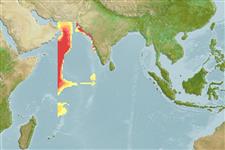Teleostei (teleosts) >
Carangaria/misc (Various families in series Carangaria) >
Polynemidae (Threadfins)
Etymology: Polydactylus: Greek, poly = a lot of + greek, daktylos = finger (Ref. 45335).
Eponymy: Jai Phirozshah Mullan (d: 1957) was an entomologist at St. Xavier’s College, Bombay, India. He discovered this species and sent specimens to Hora for study. (Ref. 128868), visit book page.
More on author: Hora.
Environment: milieu / climate zone / depth range / distribution range
Ecology
Marine; pelagic-oceanic; depth range 14 - 115 m (Ref. 40958). Tropical; 26°N - 15°S, 59°E - 74°E (Ref. 57343)
Western Indian Ocean: Arabian Sea.
Size / Weight / Age
Maturity: Lm ? range ? - ? cm
Max length : 22.2 cm TL male/unsexed; (Ref. 121653); 28.5 cm TL (female); max. published weight: 135.00 g (Ref. 121653); max. published weight: 135.00 g
Dorsal spines (total): 9; Dorsal soft rays (total): 12 - 13; Anal spines: 3; Anal soft rays: 11 - 12; Vertebrae: 24. With 7 pectoral filaments; uppermost extending well beyond posterior tip of pectoral fin. Pectoral fin rays 19-22% of SL; all rays branched except uppermost 1 or 2. Well-developed swim bladder. A large black spot anteriorly on lateral line (Ref. 40958).
Feeds on shrimps and small fishes (Ref. 57343).
Life cycle and mating behavior
Maturity | Reproduction | Spawning | Eggs | Fecundity | Larvae
Motomura, H. and Y. Iwatsuki, 2001. Review of Polydactylus species (Perciformes: Polynemidae) characterized by a large black anterior lateral line spot, with descriptions of two new species. Ichthyol. Res. 48(4):337-354. (Ref. 40958)
IUCN Red List Status (Ref. 130435: Version 2024-1)
Threat to humans
Harmless
Human uses
Fisheries: highly commercial
Tools
Special reports
Download XML
Internet sources
Estimates based on models
Preferred temperature (Ref.
123201): 23.5 - 27.2, mean 25.6 °C (based on 29 cells).
Phylogenetic diversity index (Ref.
82804): PD
50 = 0.5000 [Uniqueness, from 0.5 = low to 2.0 = high].
Bayesian length-weight: a=0.00741 (0.00464 - 0.01185), b=3.05 (2.91 - 3.19), in cm total length, based on LWR estimates for this species & (Sub)family-body (Ref.
93245).
Trophic level (Ref.
69278): 3.9 ±0.66 se; based on food items.
Generation time: 1.9 ( na - na) years. Estimated as median ln(3)/K based on 1
growth studies.
Resilience (Ref.
120179): High, minimum population doubling time less than 15 months (Preliminary K or Fecundity.).
Fishing Vulnerability (Ref.
59153): Low vulnerability (19 of 100).
